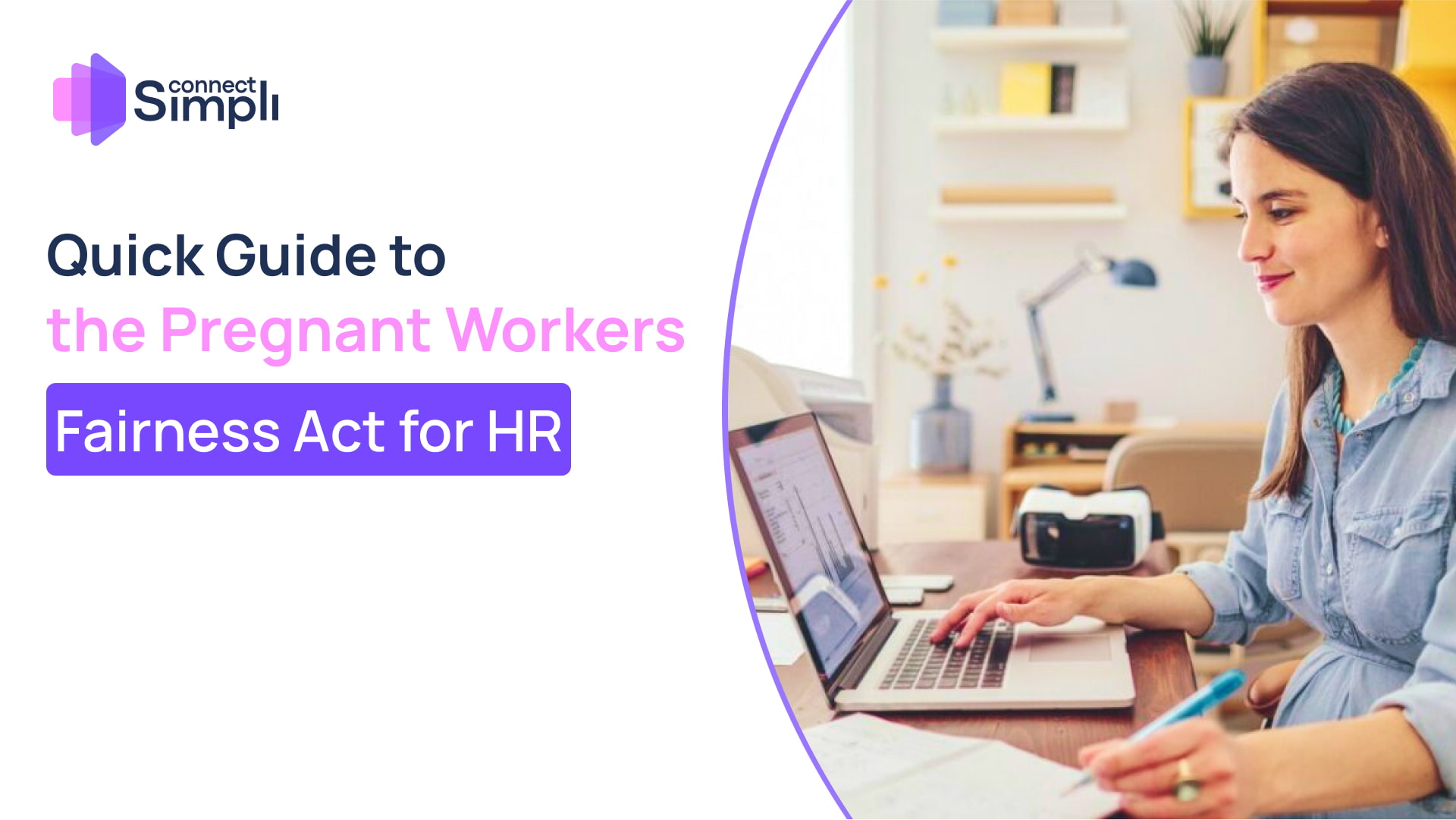Navigating workplace laws can sometimes feel like finding your way through a maze. However, the Pregnant Workers Fairness Act (PWFA) simplifies things when it comes to supporting pregnant workers. Understanding the PWFA is crucial whether you’re an HR professional or a business owner. Let’s break it down together and make it as straightforward as possible.
What is PWFA (Pregnant Workers Fairness Act)?
The Pregnant Workers Fairness Act (PWFA) is a transformative step in workplace rights, aiming to ensure that pregnant workers receive fair treatment and necessary accommodations. This legislation fills critical gaps in protections for working individuals who are pregnant, postpartum, or experiencing related medical conditions, marking a significant shift in workplace equality.
By understanding the PWFA, employers can foster a supportive environment while ensuring compliance with legal requirements. This guide provides HR professionals with the tools to navigate the Act’s intricacies and implement best practices.
Historical Context of Workplace Protections for Pregnant Workers
Workplace protections for pregnant workers have evolved significantly over the years. Earlier laws, such as the Pregnancy Discrimination Act (PDA) of 1978, laid the groundwork by prohibiting discrimination based on pregnancy. However, gaps remained, particularly around the provision of accommodations.
Milestones like the Americans with Disabilities Act (ADA) further extended protections to certain pregnancy-related conditions. Introducing the PWFA marks a pivotal moment in ensuring comprehensive rights for pregnant employees, addressing limitations in earlier legislation.

What is the Pregnant Workers Fairness Act?
The Pregnant Workers Fairness Act, effective June 27, 2023, mandates reasonable accommodations for workers affected by pregnancy, childbirth, or related conditions. The law requires employers to interact with employees to identify suitable accommodations, ensuring their needs are met without undue hardship.
Key provisions include:
- Prohibiting discrimination against pregnant workers.
- Requiring reasonable accommodations.
- Protecting employees from retaliation or adverse actions.
Coverage and Applicability of the PWFA
Who is Covered by the PWFA?
The PWFA applies to employers with 15 or more employees. It covers pregnant workers and those with medical conditions related to pregnancy or childbirth.
Applicability Across Industries and States
While the PWFA establishes a federal standard, it complements state-level protections, ensuring a baseline of rights regardless of geographic location. Employers must also account for state-specific laws offering broader protections.

Rights and Protections Under the PWFA
Reasonable Accommodations
The Act requires employers to provide adjustments to enable employees to perform their duties. Examples include modified workstations or flexible schedules.
Prohibited Discriminatory Practices
Employers cannot:
- Deny employment opportunities based on pregnancy.
- Refuse reasonable accommodations.
- Retaliate against employees requesting accommodations.
Responsibilities of Employers
The Pregnant Workers Fairness Act (PWFA) places clear responsibilities on employers to ensure compliance and foster an inclusive workplace. Here are the key obligations that employers must adhere to:
1. Provide Reasonable Accommodations
Employers are required to provide reasonable accommodations to workers affected by pregnancy, childbirth, or related medical conditions. These accommodations allow employees to perform their job duties safely and effectively without undue hardship to the employer. Examples include:
- Modifying work schedules.
- Providing light-duty assignments.
- Allowing more frequent restroom breaks.
- Offering seating or ergonomic modifications.

2. Engage in the Interactive Process
Employers must participate in a collaborative and open dialogue with employees to determine suitable accommodations. Known as the interactive process, this involves:
- Listening to the employee’s needs.
- Assessing how those needs can be met within the scope of the workplace.
- Proposing and implementing feasible solutions.
3. Prohibit Discriminatory Practices
Employers must ensure that pregnant workers are not subjected to any form of discrimination. This includes:
- Denying employment opportunities due to pregnancy.
- Refusing to provide reasonable accommodations.
- Treating pregnant workers unfavorably compared to other employees.
4. Avoid Retaliation
Retaliation against employees who exercise their rights under the PWFA is strictly prohibited. Employers cannot:
- Penalize employees for requesting accommodations.
- Demote or terminate employees for engaging in protected activities.
- Create a hostile work environment as a result of accommodation requests.
5. Prevent Forced Leave
Employers cannot force pregnant workers to take leave if a reasonable accommodation allows them to continue performing their jobs. Leave should only be used as a last resort if accommodations are impossible without undue hardship.
6. Understand and Comply with Coverage
The PWFA applies to employers with 15 or more employees. Employers must:
- Familiarize themselves with the law’s provisions.
- Ensure all HR policies and practices align with its requirements.
7. Train Management and Staff
Employers must train supervisors, managers, and HR personnel on:
- Identifying requests for accommodations.
- Responding appropriately to those requests.
- Understanding and implementing the PWFA’s provisions.
8. Maintain Documentation
To avoid legal risks and ensure accountability, employers should document all of the following:
- Requests for accommodations.
- Steps were taken during the interactive process.
- Final agreements or decisions related to accommodations.
9. Balance Accommodations with Business Needs
While employers must provide reasonable accommodations, they are not required to implement solutions that impose an undue hardship. However, they must provide clear and documented justification if an accommodation request is denied on these grounds.
10. Stay Updated on Related Laws
The PWFA interacts with laws such as the Americans with Disabilities Act (ADA) and the Family and Medical Leave Act (FMLA). Employers must ensure compliance with all applicable laws to protect employees and avoid legal pitfalls.
By fulfilling these responsibilities, employers can comply with the PWFA and create a workplace culture that values diversity, inclusion, and employee well-being. Non-compliance with the PWFA can lead to legal action, financial penalties, and damage to the company’s reputation. Therefore, it’s crucial for employers to understand and adhere to this law.

Examples of Reasonable Accommodations
- Adjusting workloads or schedules.
- Providing ergonomic equipment.
- Offering light-duty assignments.
By tailoring accommodations to individual needs, employers can create a supportive environment.
Understanding the Interactive Process
Effective implementation of the PWFA hinges on the interactive process. This collaborative approach involves:
- Identifying the employee’s needs.
- Exploring potential accommodations.
- Implementing agreed-upon solutions.
Interplay Between the PWFA and Other Laws

The Pregnant Workers Fairness Act (PWFA), effective June 27, 2023, interacts with several existing federal laws designed to protect workers’ rights. Understanding how the PWFA works alongside these laws is crucial for ensuring compliance and creating a supportive workplace for employees.
1. PWFA and the Americans with Disabilities Act (ADA)
The ADA protects employees with disabilities by requiring employers to provide reasonable accommodations. While the ADA sometimes applies to pregnancy-related conditions (such as gestational diabetes or preeclampsia), it does not cover all aspects of pregnancy.
- Key Differences:
- The PWFA explicitly includes pregnancy and related medical conditions, even when they do not qualify as disabilities under the ADA.
- The interactive process required under both laws is similar, encouraging collaboration between employers and employees to identify accommodations.
- Example: An employee experiencing normal pregnancy-related fatigue may not qualify for ADA protections but is covered under the PWFA.
2. PWFA and the Pregnancy Discrimination Act (PDA)
The Pregnancy Discrimination Act (PDA), enacted in 1978, prohibits discrimination based on pregnancy, childbirth, or related conditions. It ensures pregnant employees are treated the same as others who are similar in their ability or inability to work.
- Key Differences:
- The PDA focuses on anti-discrimination but does not require employers to provide accommodations unless they do so for other employees with similar limitations.
- The PWFA goes further by mandating employers provide reasonable accommodations for pregnant workers.
- Example: Under the PDA, an employer must not fire a pregnant worker for needing more breaks, but under the PWFA, they are required to accommodate her need for additional rest periods.
3. PWFA and the Family and Medical Leave Act (FMLA)
The FMLA provides eligible employees with unpaid leave for up to 12 weeks for particular family and medical reasons, including childbirth and recovery.
- Key Differences:
- The FMLA focuses on leave for medical and family needs, whereas the PWFA emphasizes accommodations to enable pregnant employees to continue working.
- The PWFA encourages keeping employees at work through adjustments rather than defaulting to leave.
- Example: A pregnant worker needing lighter duties to stay on the job would be covered under the PWFA. If her medical condition worsens and she cannot work, she might qualify for FMLA leave.
4. PWFA and Title VII of the Civil Rights Act
Title VII prohibits employment discrimination based on race, color, religion, sex, or national origin. The PDA is an amendment to Title VII, protecting against sex discrimination related to pregnancy.
- Key Differences:
- While Title VII focuses broadly on equal treatment, the PWFA is specific to proactive accommodations for pregnant workers.
- Example: Title VII ensures a pregnant employee isn’t excluded from training programs, while the PWFA ensures she has the accommodations necessary to participate.
5. PWFA and State Laws
Many states have pregnancy accommodation laws, some offering greater protections than the PWFA. Employers must comply with whichever law provides the most benefits to employees.
- Example: If a state law mandates more extended break periods than the PWFA, the employer must follow the state’s law.
The PWFA complements and builds upon existing workplace protections, ensuring a comprehensive framework for pregnant workers. While the ADA, PDA, FMLA, and Title VII address overlapping aspects of workplace rights, the PWFA specifically addresses the gaps by mandating accommodations for all pregnant workers. For employers, understanding the interplay between these laws ensures legal compliance and fosters an equitable and inclusive workplace.
Implementation Strategies for HR Professionals
The Pregnant Workers Fairness Act (PWFA) introduces new requirements for accommodating pregnant employees, making its effective implementation crucial for HR professionals. To ensure compliance and create a supportive work environment, HR teams should focus on the following strategies:
1. Update Workplace Policies and Handbooks

HR professionals must revise existing policies to align with the PWFA’s requirements. Clear documentation helps employees understand their rights and ensures managers apply consistent practices.
- Steps to Update Policies:
- Include language about the PWFA and its accommodation requirements.
- Specify the procedure for requesting accommodations.
- Highlight the prohibition of discrimination and retaliation.
- Communicate Updates: Share revised policies with all employees through internal communications, ensuring they are accessible in employee handbooks and online platforms.
2. Train Supervisors and Managers
Supervisors play a critical role in recognizing and addressing accommodation requests. Training them ensures compliance and minimizes potential legal risks.
- Key Training Topics:
- Overview of the PWFA and its requirements.
- Identifying and responding to accommodation requests.
- Engaging in the interactive process effectively.
- Avoiding discriminatory practices and retaliation.
- Delivery Methods: Use workshops, online training modules, or in-person seminars to ensure thorough understanding.
3. Establish a Clear Process for Accommodation Requests
A well-defined process ensures that employees know how to request accommodations and that requests are handled consistently and efficiently.
- Steps for a Clear Process:
- Provide employees with a designated contact person (e.g., HR representative).
- Outline how to submit requests (written or verbal).
- Explain the steps involved in the interactive process.
- Set timelines for responding to requests.
- Document Requests: Maintain detailed records of all accommodation discussions, agreements, and actions.
4. Foster a Culture of Inclusion and Support
Creating an environment where employees feel comfortable discussing pregnancy-related needs is essential.
- Best Practices:
- Promote open communication between employees and management.
- Encourage empathy and understanding in workplace interactions.
- Highlight success stories of accommodations to normalize the process.
5. Conduct a Workplace Needs Assessment
Evaluate your workplace to identify potential barriers and opportunities for improvement.
- Assessment Areas:
- Physical workspace modifications (e.g., ergonomic chairs, private lactation areas).
- Flexible scheduling options.
- Access to support services or resources for pregnant employees.
6. Implement Compliance Monitoring
Regular audits help ensure that the organization remains compliant with the PWFA.
- Compliance Checklist:
- Are policies and training programs updated?
- Are accommodation requests processed and documented correctly?
- Are employee rights being upheld consistently?
- Tools: Use software or third-party services to track compliance metrics and identify gaps.
Effective implementation of the PWFA requires a proactive and strategic approach by HR professionals. HR teams can ensure compliance while supporting pregnant employees by updating policies, training staff, and fostering a culture of inclusion. Prioritizing these strategies meets legal obligations and demonstrates a commitment to workplace equity and employee well-being.
Implementation Strategies for HR Professionals Under the Pregnant Workers Fairness Act (PWFA)
The Pregnant Workers Fairness Act (PWFA) introduces new requirements for accommodating pregnant employees, making its effective implementation crucial for HR professionals. To ensure compliance and create a supportive work environment, HR teams should focus on the following strategies:
1. Update Workplace Policies and Handbooks
HR professionals must revise existing policies to align with the PWFA’s requirements. Clear documentation helps employees understand their rights and ensures managers apply consistent practices.
- Steps to Update Policies:
- Include language about the PWFA and its accommodation requirements.
- Specify the procedure for requesting accommodations.
- Highlight the prohibition of discrimination and retaliation.
- Communicate Updates: Share revised policies with all employees through internal communications, ensuring they are accessible in employee handbooks and online platforms.
2. Train Supervisors and Managers
Supervisors play a critical role in recognizing and addressing accommodation requests. Training them ensures compliance and minimizes potential legal risks.
- Key Training Topics:
- Overview of the PWFA and its requirements.
- Identifying and responding to accommodation requests.
- Engaging in the interactive process effectively.
- Avoiding discriminatory practices and retaliation.
- Delivery Methods: Use workshops, online training modules, or in-person seminars to ensure thorough understanding.
3. Establish a Clear Process for Accommodation Requests
A well-defined process ensures that employees know how to request accommodations and that requests are handled consistently and efficiently.
- Steps for a Clear Process:
- Provide employees with a designated contact person (e.g., HR representative).
- Outline how to submit requests (written or verbal).
- Explain the steps involved in the interactive process.
- Set timelines for responding to requests.
- Document Requests: Maintain detailed records of all accommodation discussions, agreements, and actions.
4. Foster a Culture of Inclusion and Support
Creating an environment where employees feel comfortable discussing pregnancy-related needs is essential.
- Best Practices:
- Promote open communication between employees and management.
- Encourage empathy and understanding in workplace interactions.
- Highlight success stories of accommodations to normalize the process.
5. Conduct a Workplace Needs Assessment
Evaluate your workplace to identify potential barriers and opportunities for improvement.
- Assessment Areas:
- Physical workspace modifications (e.g., ergonomic chairs, private lactation areas).
- Flexible scheduling options.
- Access to support services or resources for pregnant employees.
6. Implement Compliance Monitoring
Regular audits help ensure that the organization remains compliant with the PWFA.
- Compliance Checklist:
- Are policies and training programs updated?
- Are accommodation requests processed and documented correctly?
- Are employee rights being upheld consistently?
- Tools: Use software or third-party services to track compliance metrics and identify gaps.
Effective implementation of the PWFA requires a proactive and strategic approach by HR professionals. HR teams can ensure compliance while supporting pregnant employees by updating policies, training staff, and fostering a culture of inclusion. Prioritizing these strategies meets legal obligations and demonstrates a commitment to workplace equity and employee well-being.
Compliance Checklists for HR
Ensuring compliance with the Pregnant Workers Fairness Act (PWFA) is a critical responsibility for HR professionals. A well-organized compliance checklist helps streamline the process and minimizes risks. Below is a comprehensive checklist tailored for HR departments to implement the PWFA effectively:
1. Policy and Documentation Updates
- Review Current Policies: Ensure workplace policies reflect PWFA requirements.
- Revise Employee Handbooks: Update handbooks to include details about employee rights under the PWFA.
- Create an Accommodation Policy: Develop a clear policy outlining how employees can request accommodations and how these requests will be handled.
- Document Accommodation Processes: Implement templates for recording requests, decisions, and steps taken during the interactive process.
2. Training and Awareness
- Train HR Staff: Educate HR professionals on the requirements and responsibilities of the PWFA.
- Educate Supervisors and Managers: Provide training on appropriately identifying and handling accommodation requests.
- Conduct Employee Awareness Sessions: Inform employees about their rights under the PWFA and the process for requesting accommodations.
3. Establish an Accommodation Process
- Designate a Point of Contact: Assign a dedicated HR representative to handle accommodation requests.
- Develop a Request Submission Procedure: Allow verbal and written requests to accommodate employee preferences.
- Outline the Interactive Process: Define clear steps for engaging in discussions with employees to identify appropriate accommodations.
- Set Timelines: Establish reasonable timeframes for responding to and implementing accommodation requests.
4. Physical Workspace and Resources
- Assess Workspaces: Identify areas requiring modifications, such as ergonomic adjustments or adding private spaces.
- Prepare Common Accommodations: Stock ergonomic equipment or frequently requested items, such as stools or adjustable desks.
- Set Up Lactation Areas: Ensure private, clean, accessible lactation rooms are available.
5. Compliance with Related Laws
- Understand Legal Interplay: Review how the PWFA interacts with laws like the ADA, PDA, and FMLA.
- Stay Updated on State Laws: Verify that state-specific requirements are incorporated into your compliance strategy.
- Consult Legal Counsel: Regularly review policies and accommodation decisions with legal experts to ensure full compliance.
6. Monitoring and Documentation
- Track Accommodation Requests: Maintain detailed records of all requests and the steps to address them.
- Document Decisions: Record the rationale for approving or denying accommodation requests, particularly if citing undue hardship.
- Monitor Trends: Analyze data on accommodations to identify recurring issues and improve processes.
7. Communication Strategies
- Create Clear Communication Channels: Establish a system for employees to reach HR with questions or requests easily.
- Provide Regular Updates: Keep employees informed about their rights and any changes to workplace policies.
- Offer Anonymous Feedback Options: Allow employees to share concerns or feedback without fear of retaliation.
8. Regular Compliance Audits
- Schedule Periodic Reviews: Conduct audits to ensure all aspects of PWFA compliance are met.
- Address Gaps: Identify and resolve any discrepancies found during compliance reviews.
- Update Practices: Revise policies and training materials based on audit findings or regulatory changes.
9. Address Employer Concerns
- Balance Accommodations and Business Needs: Work with management to implement accommodations that meet employee and operational requirements.
- Clarify Undue Hardship Criteria: Ensure managers understand when and how undue hardship can be cited, with appropriate documentation.
10. Utilize External Resources
- Engage with EEOC: Access training, guidance, and resources provided by the Equal Employment Opportunity Commission (EEOC).
- Consult with Experts: Work with legal advisors or third-party compliance specialists to stay updated on best practices.
- Use HR Tools: Leverage HR software to track accommodation requests and ensure compliance.
11. Foster a Culture of Support
- Promote Inclusion: Ensure employees feel valued and supported throughout their pregnancy journey.
- Encourage Open Dialogue: Build trust so employees feel comfortable discussing their needs with HR and management.
By following this compliance checklist, HR professionals can effectively implement the PWFA, mitigate risks, and promote a workplace culture that values equity and inclusion. Regularly updating policies, training staff, and monitoring compliance will ensure that employees and employers benefit from PWFA protections.
Frequently Asked Questions (FAQs)
- Who does the PWFA apply to?
Employers with 15 or more employees.
- What constitutes a reasonable accommodation?
Adjustments such as modified duties or flexible schedules.
- How does the PWFA differ from the PDA?
The PWFA emphasizes accommodations, whereas the PDA focuses on anti-discrimination.
- Can employers deny accommodations due to cost?
Only if the accommodation imposes an undue hardship.
- Are part-time employees covered?
Yes, if they meet the criteria under the PWFA.
- How should employees request accommodations?
Through written or verbal communication with their employer.
Conclusion: Moving Towards Inclusive Workplaces
The Pregnant Workers Fairness Act is a landmark step in fostering inclusive and equitable workplaces. By prioritizing compliance and employee well-being, HR professionals can create environments where all employees thrive.

